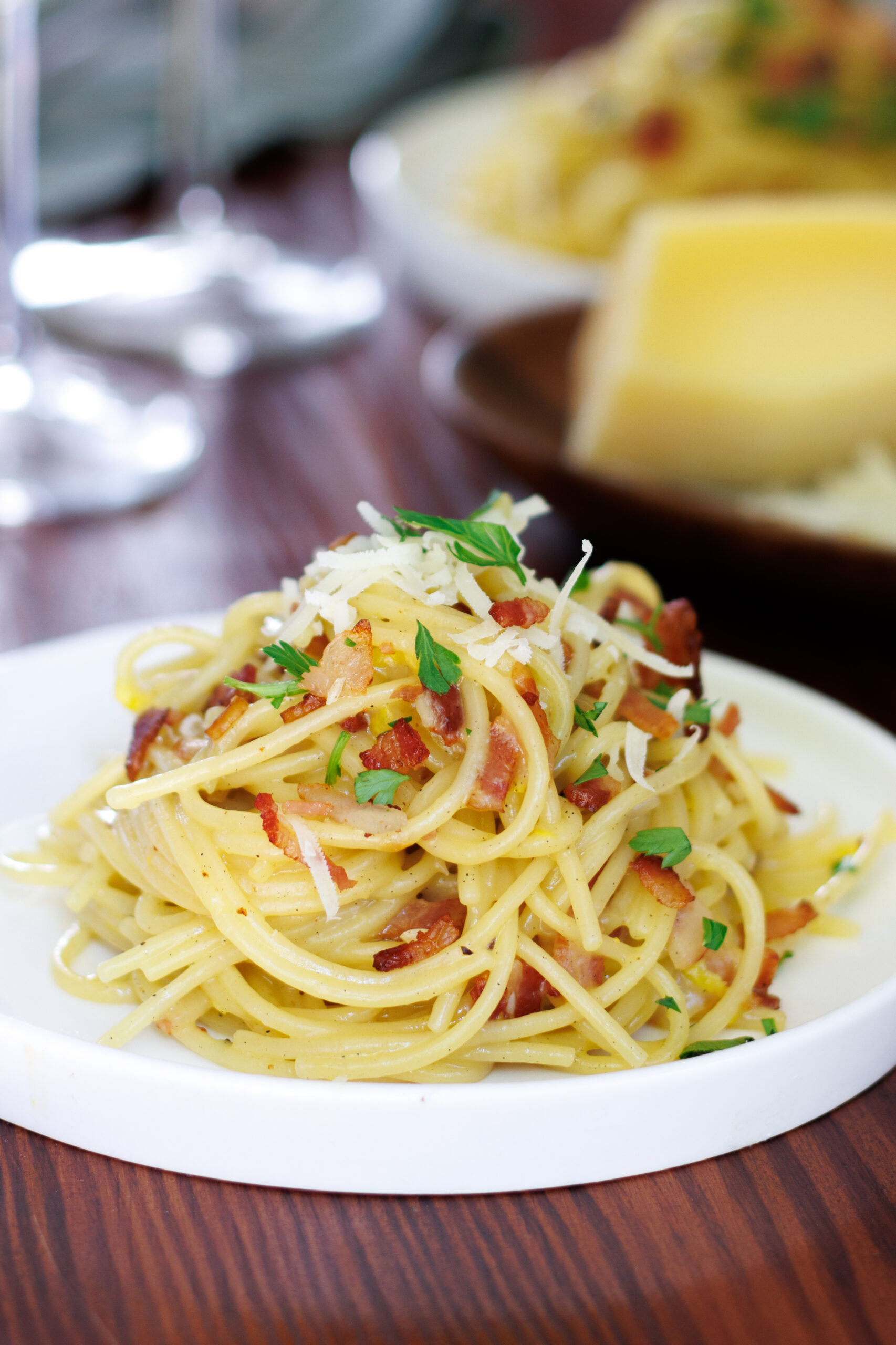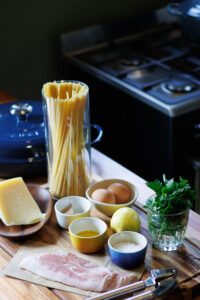Roman Spaghetti Carbonara

When it gets to pasta dishes, this mid-20th-century Italian pasta dish is the ultimate luxury, which in turn provides some explanation as to why you won’t find spaghetti carbonara in many restaurants. It demands care and attention to detail but the reward will transport you to Italy and I think it is this exceptional quality that makes it the perfect meal for a very special occasion.
Traditionally, in Rome, spaghetti carbonara is al dente cooked spaghetti or linguine tossed in an emulsion of eggs, sheep’s milk cheese, Pecorino Romano, or cow’s milk cheese, Parmigiano Reggiano and lemon zest, seasoned with crispy pancetta.
If I were to describe the flavor and texture of a spaghetti carbonara, I’d say what you end up with is a silky smooth, creamy sauce delicately flavored by the saltiness of parmesan or pecorino, enriched with smokey pancetta, and elevated by the freshness of the lemon zest. As if this rich, creaminess is not enough, crispy pancetta and garlic are sprinkled over the top with a few speckles of freshly ground black pepper. Nothing more is required, in fact, anything else would take rather than give to this pasta.

The key to the best carbonara you will ever have is using the best-quality cheese and eggs, cooked gently over the subtlest heat.
Notes on serving sizes:
Making this recipe for 2 is a matter of halving all the ingredient quantities – I use about 200g of durum wheat pasta to serve 2 people. Likewise, the recipe can also be upscaled to serve a bigger crowd. If you’re making a bigger batch, use a larger casserole/ pan to make tossing and stirring the pasta easier, ensuring a smoother emulsion.
You can view my YouTube channel “Cooking In The Veld” by clicking the link below or by scanning the QR code.
YouTube Recipe Vlog: https://linktr.ee/Stean_Kruger


Spaghetti Carbonara
Ingredients
- 400 g spaghetti or linguine
- 4 large eggs whisked
- 180 g parmesa or pecorino cheese grated (plus some for serving)
- 1 tbsp olive oil
- 200 g pancetta or streaky bacon finely diced
- 2 cloves garlic minced
- 1-2 c pasta water
- Salt & freshly ground black pepper
Instructions
- Bring a large casserole with water to a boil and add 1 tbsp of sea salt flakes. Cook the pasta until al dente (tender, yet still firm and chewy), this takes approximately 6 minutes. Drain the pasta and reserve 1-2 cups of starchy pasta water.
- While the pasta cooks, add the olive oil to a heavy-base castiron pan over medium-high heat and fry the bacon until golden and crisp. Add the garlic and cook for 30 seconds before turning off the heat.
- In the meanwhile, whisk together the eggs and grated parmesan or pecorino. Season with salt and pepper, keeping in mind that the cheese may be salty enough. Add ½ cup of the reserved pasta water to the egg and cheese mixture and beat thoroughly.
- As soon as the pasta is cooked, add it to the hot pan with bacon and garlic. If the pan has cooled down, heat the pan until the bacon and pasta begin to sizzle, switch off the heat completely and proceed to the next step.
- Pour the cheese and egg mixture over the pasta and bacon. Now, working fast, continuously lift and toss the pasta using two forks or utensils. You want the egg mixture to emulsify and slightly thicken into a smooth, creamy sauce that coats the pasta without scrambling the eggs. This only takes 3-5 minutes and the residual heat of the cooked pasta and pan should be enough to cook and thicken the sauce. If the mixture is too sticky or dry, slowly add some more pasta water and continue to toss until the desired consistency is reached.
- Sprinkle over the crispy bacon and garlic, freshly ground black pepper, and some more parmesan cheese. Serve immediately.
- To warm the pasta, heat over medium heat while adding in a little more pasta water to make it creamy again.
Notes
- I cannot stress the importance low, gentle heat enough when making carbonara. Remove the pan from the heat immediately if the sauce starts to bubble or spit. You want to avoid scrambling the eggs at all costs.


